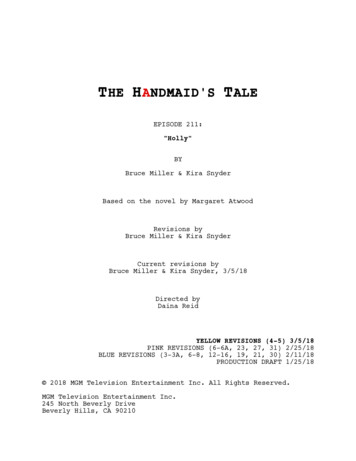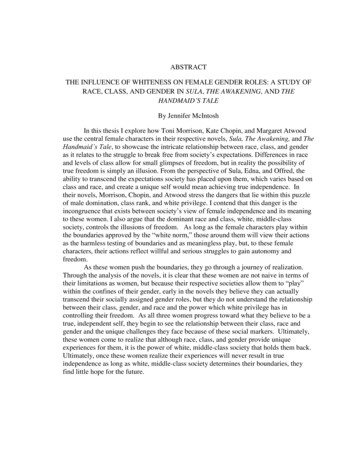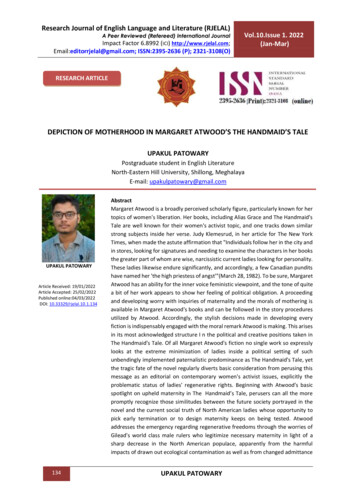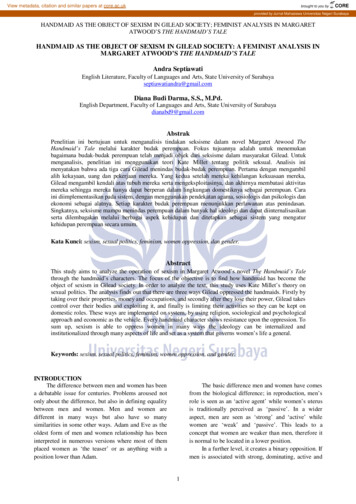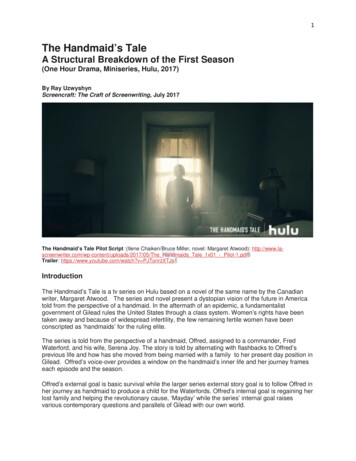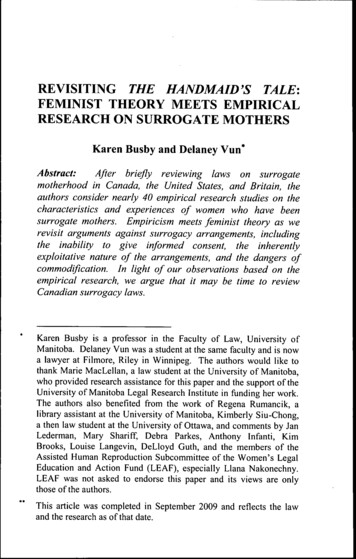
Transcription
REVISITING THE HANDMAID'S TALE:FEMINIST THEORY MEETS EMPIRICALRESEARCH ON SURROGATE MOTHERSKaren Busby and Delaney Vun*Abstract:After briefly reviewing laws on surrogatemotherhood in Canada, the United States, and Britain, theauthors consider nearly 40 empirical research studies on thecharacteristics and experiences of women who have beensurrogate mothers. Empiricism meets feminist theory as werevisit arguments against surrogacy arrangements, includingthe inability to give informed consent, the inherentlyexploitative nature of the arrangements, and the dangers ofcommodification. In light of our observations based on theempirical research, we argue that it may be time to reviewCanadian surrogacy laws.Karen Busby is a professor in the Faculty of Law, University ofManitoba. Delaney Vun was a student at the same faculty and is nowa lawyer at Filmore, Riley in Winnipeg. The authors would like tothank Marie MacLellan, a law student at the University of Manitoba,who provided research assistance for this paper and the support oftheUniversity of Manitoba Legal Research Institute in funding her work.The authors also benefited from the work of Regena Rumancik, alibrary assistant at the University of Manitoba, Kimberly Siu-Chong,a then law student at the University of Ottawa, and comments by JanLederman, Mary Shariff, Debra Parkes, Anthony Infanti, KimBrooks, Louise Langevin, DeLloyd Guth, and the members of theAssisted Human Reproduction Subcommittee of the Women's LegalEducation and Action Fund (LEAF), especially Liana Nakonechny.LEAF was not asked to endorse this paper and its views are onlythose of the authors.This article was completed in September 2009 and reflects the lawand the research as ofthat date.
14CANADIAN JOURNAL OF FAMILY LAW [Vol. 26, 2010]INTRODUCTIONMargaret Atwood's powerful 1985 novel. The Handmaid'sTale, speculates about a near future in Gilead (formerly theUnited States), a eountry ruled by a puritanical theocracy.Most adults are infertile beeause of pollution, radiation anddisease. Aeeording to the Biblical story, the original Gilead isthe plaee where, according to the Biblieal story, Joseph and thefour women (two wives and two slaves) with whom he hadchildren settled. Fertile women in the modem Gilead areforeed to be "handmaids", the term used in one translation todescribe Joseph's slaves, who had been impregnated bypowerful men. The ehildren of these unions were raised as theoffspring of that man and his wife. Other Biblieally-basedGileadean pro-natalist laws make it a eapital offenee to engagein non-reproduetive sex or to have an abortion, unless the fetusevidenees a disability. In Atwood's novel, a handmaid narratesher story onto audiotapes beeause women are forbidden to reador write. Personal voice and oral history have long been usedby marginalized people to make some sense of theirpredieament. Many feminist seholars understand TheHandmaid's Tale to be a novel about the exploitative, dehumanizing elements of surrogate motherhood.'Richard F. Storrow, "77îe Handmaid's Tale of Fertility Tourism:Passports and Third Parties in the Religious Regulation of AssistedConception" (2005) 12 Tex. Wesleyan L. Rev. 189, citing, forexample, Helene Michie & Naomi R. Cahn, "Confinements andFertility and Infertility in Contemporary Culture" (1997) and LindaMysiades, "Law, Medicine, and the Sex Slave in Margaret Atwood'sThe Handmaid's Tale" in Kostas Myrsiades & Linda Myrsiades, eds.,Undisciplining Literature: Literature, Law and Culture (New York:Peter Lang New York, 1999). Storrow's article also has an interestingreview of Egyptian and Muslim law related to surrogacyarrangements.
Revisiting The Handmaid's Tale15In early 1986, American Mary Beth Whitehead gavebirth to a child conceived by artificial insemination, using heregg and the commissioning father's sperm. She had signed asurrogacy contract to give up all parental rights and she was toreceive 10,000 as compensation. Shortly after the birth, shedetermined that she could not give up the child and a lawsuit,In the Matter of Baby M} ensued between the two geneticparents. At the trial in 1987, her fitness as a parent wasquestioned on rather dubious criteria. Experts criticized herchoice of stuffed teddy bears as toys and how she played "pattycake" with M. They also stated that she had a narcissisticpersonality and used her dyed hair to support their diagnosis. The court, after finding that there was a binding contract,ordered the termination of Whitehead's parental rights, gavecustody to the commissioning father, and permitted him and hiswife to immediately adopt the child. On appeal in 1988, thecourt held the contract was void. The appeal court stated that asurrogate mother could not give meaningful consent torelinquish a child until after the child was bom and that it isillegal to pay someone to be a surrogate or to sell a baby.Therefore, the court rescinded the adoption. Using the "bestinterests of the child" test, it held that the commissioning fathershould have custody (finding that his home was more stableIn the Matter of Baby M.IM N.J. Super 313 (Ch. Div. 1987) rev'd109 N.J. 396(1988).More than 100 prominent feminists, including Betty Freidan, MerylStreep, Gloria Steinem and Phyllis Chesler, signed a statement titled"By these standards we are all unfit mothers", criticizing the expertevidence presented on Whitehead's mothering skills. See also IverPeterson, "Fitness Test for Baby M's Mother Unfair, Feminists Say",The New York Times (20 March 1987), online: The New York .html and Phyllis Chesler, TheSacred Bond: The Legacy of the Baby M Case (New York: TimesBooks, 1988).
16CANADIAN JOURNAL OF FAMILY LAW [Vol. 26, 2010]and fmancially secure) and the surrogate mother should havevisitation rights. The Baby Mease ignited a firestorm of publicand academic debates on the ethics of commercial surrogacyarrangements. Feminists were almost uniformly supportive ofthe suiTOgate mother. The Handmaid's Tale and the Baby Mcase both served as influential cautionary tales of women inimaginary and real regimes that forced them to become, asdescribed by one of Atwood's characters, "sacred vessels,ambulatory chalices",'* or, in other words, surrogate mothers.The Canadian government formed the RoyalCommission on New Reproductive Technologies ("RCNRT")in 1989 and reported in 1993. It recommended prohibiting allsurrogacy arrangements on pain of significant criminalsanctions, asserting that women could not give true consent torelinquish parental rights and that the practice exploitedvulnerable women and would commodify women andchildren. The RCNRT's analysis reflected most popular andacademic feminist thinking in Canada and the United States inMargaret Atwood, The Handmaid's Tale (Toronto: Random House,1986) at 196.Royal Commission on New Reproductive Technologies, Proceedwith Care: Final Report of the Royal Commission on NewReproductive Technologies, vol. 2 (Ottawa: Minister of GovernmentServices Canada, 1993) [RCNRT] at, for example, xxxii, 15, 22, 52,107, 199, and Recommendations 199-205.Canadian feminists who opposed surrogacy included ChristineOverall, see Human Reproduction: Principles, Practices and Policies(Toronto: Oxford University Press, 1993) [Overall, "HumanReproduction"] and Ethics and Human Reproduction: A FeministAnalysis (Allen & Unwin: Boston, 1987) [Overall, "A FeministAnalysis"]; Somer Brodribb, see "Off the Pedastal and Onto theBlock", (1986) 1 Canadian Journal of Women and the Law/Review"Femmes et Droit" 407; Michèle Landsberg, see "Baby M decisionbacking an inhumane practice" Globe and Mail (4 April 1987) A2;Margrit Eichler, see "Reflections on the 'Temporary Use of NormallyFunctioning Uteri'" in Gwen Basen, Margrit Eichler, & Abby
Revisiting The Handmaid's Tale17the 1980s and early 1990s. For example, Christine Overall, aninfluential feminist ethicist, questioned whether the choice toenter a surrogate contract could be a free one and postulatedthat it is impossible for a surrogate to be fully informed of thefull potential of the traumas they could experience uponsurrender of the child. She asserted that surrogate mothers"often have little education, little or no income, and very littlepersonal security" and are therefore ripe for exploitation. Shedescribed the practice as "reproductive prostitution" and statedthat "the argument here is not that selling babies leads, via theslippery slope, to slavery; the claim is that the practice isLippman, eds. Misconceptions: The Social Construction of Choiceand New Reproductive and Genetic Technologies (Hull, Quebec:Voyaguer, 1993); Diana Majury, see "Pre-Conception Contracts:Giving the Mother an Option" in Simon Rosenfeld & Peter Findlay,eds. Debating Canada's Future: Views from the Left (Toronto:James Lorimer & Co., 1991); and Susan Sherwin, see "SomeReflections on 'Surrogacy"' in Basen, Eichler, & Lippman. Americanfeminists opposing surrogacy ineluded: Mary Lyndon Shanley, see"'Surrogate Mothering' and Women's Freedom: A Critique ofContracts for Human Reproduction" (1993) 18 Signs 618; MarthaField, see Surrogate Motherhood: The Legal and Human Issues(Cambridge: Harvard University Press, 1988); Janice Raymond, seeWomen As Wombs: Reproductive Technologies and the Battle OverWomen's Freedom (San Francisco: Harper Collins, 1993); Chesler,supra note 3; Barbara Katz Rothman, see Recreating Motherhood,Ideology and Technology in a Patriarchal Society (New York: W.W.Norton, 1989); Anita L. Allen, see "The Socio-Economic Struggle forEquality: The Black Surrogate Mother" (1991) Harvard Blaekletter J.17; Gena Corea, see The Mother Machine: ReproductiveTechnologies From Artificial Insemination to Artificial Wombs (NewYork: Harper & Row, 1985); and see Linda & Whiteford and Mary L.Poland, eds. New Approaches to Human Reproduction: Social andEthical Dimensions (Boulder, CO; Westview Press, 1989). (Most ofthe authors in this text illustrate this point).Overall, "A Feminist Analysis", supra note 6, at 1 and 116-118.
18CANADIAN JOURNAL OF FAMILY LAW [Vol. 26, 2010]slavery" and she eoneluded that even if a regulatory regimeprotects the rights of surrogate mothers it "is incompatible withthe vision of women as equal, autonomous, and valuedmembers of this culture". Early in the debate, few feministvoiees asserted that women should have the autonomy to makethe ehoiee to be a surrogate mother.' Onee it beeame apparentthat prohibition eoupled with eriminal sanctions was the pathlikely to be taken in Canada, some noted the dangers ofcriminalizing the behaviour of marginalized groups."*Attitudinal surveys also indicated that there was littlepublic support for surrogaey in Canada and elsewhere in the1990s. Vijaya Krishnan's 1994 survey of more than 5,300Canadian women of reproductive age found that, while 24pereent of those surveyed approved of eommereial surrogacy,42 pereent strongly disapproved. S.J. Genius et al. found in a1993 survey of 455 Edmontonians that 85 pereent wereOverall, "Human Reproduction", supra note 6, at 124 and 131.One early proponent of autonomy and choice was Carmel Shalev, seeBirth Power: The Case for Surrogacy" (New Haven; Yale UniversityPress, 1989).The National Association of Women and the Law (NAWL), whilestressing that it did not "condone" surrogacy, submitted to aParliamentary Committee in April 1997 that criminal approacheswere too heavy handed. See the evidence of Diana Majury and DianaGinn, on behalf of NAWL, online; ta/evidence/07 97-04-f0/srta07 blkl01 .html . See also, Majury, supra note 6, Mariana Valverde & LomaWeir, "Regulating New Reproductive and Genetic Technologies; AFeminist View of Recent Canadian Government Initiatives" (1997)23 Feminist Studies 418, and Alison Harvison Young & AngelaWasunna, "Wrestling with the Limits of the Law; Regulating NewReproductive Technologies" (1998) 6 Health Law J. 239.
Revisiting The Handmaid's Tale19opposed to surrogaey if eommissioning mothers used surrogaeysimply to avoid the ineonvenienee of pregnaney. "Despite the cautionary tales, early feminist thinkingand publie opinion and a 2004 criminal law in Canadaprohibiting eommereial surrogaey (discussed below), surrogaeyarrangements have persisted as a method of family formationand seem to be here to stay. Reliable statisties on how manysurrogaey arrangements are entered into are not available, butthe web sites of Ameriean and British surrogaey organizationsboast of making hundreds of connections and that at least25,000 babies have been bom to surrogate mothers in theUnited States alone.' The growing reproduetive tourismVajaya Krishnan, "Attitudes toward surrogate motherhood inCanada" (1994) 15 Health Care for Women International 333 and S.J.Genius, S.K. Chang, & S.K. Genius, "Public Attitudes in Edmontontoward assisted human reproduction" (1993) 150 Canadian MedicalAssociation Joumal 701. See also Aimee Poote & Olga van denAkker, "British women's attitudes to surrogacy" (2009) 24 HumanReproduction 139 and G. Wiess, "Public Attitudes about SurrogateMotherhood" (1992) 6 Michigan Sociological Review 15.For example. Lim Ai Lee, reports that "[a]ccording to reports quotingindustry experts, over 1,000 surrogate births took place in the UnitedStates last year, and it is believed the number has increased since therecession, as more cash-strapped women turn to surrogacy to easetheir financial burden": "Surrogacy way to survive the hard times"The [Malaysia] Star (June 29, 2009), online: Star http://thestar.com.my/columnists/story.asp?file /2009/6/27/columnists/stateside/4187899&sec stateside. It is not clear whether this figureinclude situations where the parties concluded arrangements withoutany third party assistance. Elly Teman, acknowledges that accurateestimates are impossible because so many informal arrangements takeplace and she reports that, at least, 25,000 children have been horn bysurrogates in the United States: "The Social Construction ofSurrogacy Research: An Anthropological Critique of thePsychosocial Scholarship on Surrogate Motherhood" (2008) 67Social Science & Medicine 1104. Childlessness Overcome ThroughSurrogacy (COTS) (a British organization celebrated its 600* birth in
20CANADIAN JOURNAL OF FAMILY LAW [Vol. 26, 2010]industry in India is worth more than 450 million (US).' Hardly a week goes by without the tabloids featuring acelebrity holding a child borne of a surrogate mother ortelevision programs about the practice.'"* On-line surrogacyorganizations connecting would-be surrogate mothers withcommissioning parents are numerous and ads offering orseeking commercial surrogacy services are easy-to-find (albeitnow illegal) in Canada.' Further, the British Medical2007) reports that most people who enter surrogacy arrangements donot get legal assistance. In jurisdictions where there are prohibitionson commercial surrogacy, there is evidence of "do it yourselfarrangements: COTS online: http://www.surrogacy.org.uk/AboutCOTS.htm ). A 2007 McLean's Magazine story also evidences aDIY attitude in Canada. See Jessica Webb, "Gay man seeks perfectwoman: Surrogate mothers find a new niche market: single gay men"McLeans (May 21, 2007), online: Rogers Digital Media Publishing http://www.fertilitylaw.cayarticles/macleans-01 .pdf .Usha Rengachary Smerdon, "Crossing Bodies, Crossing Borders:Intemational Surrogacy Between the United States and India", (2008)39 Cumh. L.Rev. 15.For example, in June 2009, People Magazine featured the story"Sarah Jessica Parker and Matthew Broderick have twins", online: 0.html .Thebabies were bom "with the generous help of a surrogate". The TVseries "Lie to Me" repeated "Depraved Heart", a story about womenwho killed herself after giving birth as a surrogate and the BBC airedthe documentary "Addicted to Surrogacy". Susan Merkens and TimAppleton argue that the media portrays surrogacy in a negative light,see Surrogate Motherhood and the Politics of Reproduction(Berkeley: University of Califomia Press, 2007) and "Surrogacy"(2001) II Current Opinion in Obstetrics and Gynecology 256,respectively.See Tom Blackwell, "The impotency of Canada's fertility laws"National Post (February 13, 2009), online: National Post: http://www.nationalpost.com/m/story.html?id 128838 (accessedJuly 4, 2009). See CBC, "Paid Surrogacy Driven Underground inCanada", online CBC www.cbc.ca/health/story/2007/05/01/
Revisiting The Handmaid's Tale21Association recently changed its position on surrogacyarrangements.In the mid-1980s it maintained that it wasunethical for a doctor to be involved in surrogacy; by the late1990s, it accepted it as inevitable ' The next section of this paper briefly reviewssurrogacy laws in Canada, the United States, and Britain.These three jurisdictions are the focus of this paper becausecommissioning parents in these countries are actively engagedin making surrogacy arrangements with surrogate mothers,either within their own countries or in other countries. We thenconsider recent research on the characteristics and experiencesof women who have agreed to be surrogates. In this review,which is the main focus of the paper, empiricism will meetfeminist theory as we revisit arguments against surrogacy,including the inability to give informed consent, the inherentlyexploitative nature of the arrangements and the dangers ofcommodification.Anecdotal research, both popular andtheoretical, is available, as is research based on more rigoroussurrogates-pay.html . See also Shireen Kashmeri, UnravellingSurrogacy in Ontario, Canada. An Ethnographic Inquiry on theInfluence of Canada's Assisted Human Reproduetion Act (2004),Surrogacy Contracts, Parentage Laws and Gay Fatherhood (M.A.Thesis, Concordia University Department of Sociology andAnthropology 2008) [unpublished] at 46.Kashmeri looks atCanadian lawyers who were informants.She confirms thatCanadians are traveling to the United States to engage surrogatemothers and that American commissioning parents will makearrangements with Canadian surrogates to take advantage of theCanadian health care system and the lower cost of engaging surrogatemothers. See also Mary Gazze, "Canada: Destination for InfertileCouples" Globe & Mail (June 26, 2007), A12.Olga B.A. van den Akker, "Psychosocial aspects of surrogatemotherhood" (2007) 13 Human Reproduction Update 53 [van denAkker, "Psychosocial aspects"].
22CANADIAN JOURNAL OF FAMILY LAW [Vol. 26, 2010]empirical methodologies to study the experiences of surrogatemothers. As will be described more fully, the "empirical data[consistently] offers little support for widely expressedconcerns about contractual parenting being emotionallydamaging or exploitative for surrogate mothers, children orintended/social parents".' Vasanti Jadva and her researchteam concluded, based on interviews with 34 British womenwho have been surrogate mothers, thatOverall, surrogacy appears to be a positiveexperience for surrogate mothers. Women whodecide to embark on surrogacy often havecompleted a family of their own and feel thatthey wish to help a couple who would nototherwise be able to become parents. Thepresent study lends little support to thecommonly held expectation that surrogatemothers will experience psychological problemsfollowing the birth of the child.Instead,surrogate mothers often reported a feeling ofself-worth.In addition, surrogate mothersgenerally reported positive experiences with thecommissioning couple, and many maintainedcontact with them and the child.' A challenge to the federal Assisted HumanReproduction Act Ç'AHRA") (which prohibits paying a womanto be a surrogate mother) on federalism grounds was arguedJanice C. Ciccarelli & Linda J. Beckman, "Navigating Rough Waters:An Overview of Psychological Aspects of Surrogacy" (2005) 61Journal of Social Issues 21.Vasanti Jadva, Clare Murray, Emma Lycett, Fiona MacCallum, &Susan Golombok, "Surrogacy: The Experience of Surrogate Mothers"(2003) 18 Human Reproduction 2196.
Revisiting The Handmaid's Tale23before the Supreme Court of Canada in April, 2009 (the easestarted on reference by the Quebee government, before Quebeeeourts and they were joined by the governments of Alberta,Saskatehewan and New Brunswick before the Supreme Courtof Canada). Both lower eourts declared many seetions oftheAHRA uneonstitutional." If the lower eourt deeisions areupheld, the remaining seetions of the AHRA will not makesense on their own and both the federal government andprovineial governments will need to reconsider surrogaey andother assisted human reproduction laws. Given this possibility,and in light ofthe researeh on surrogate mothers' experienees,it is timely to review Canadian laws relating to surrogaeyarrangements. We will briefly undertake sueh a review in thelast seetion ofthe paper.In this paper we refer to agreements between surrogatemothers and eommissioning parents as "surrogaeyarrangements" unless the context requires otherwise. Thisusage refleets the faet that it is unlikely that striet eontraet lawprineiples would apply if the agreements unravelled. JulietGuiehon asserts that,[t]he use of "eontraet" ineorreetly implies thateommereial law would govern in a disputedease, when in faet family law would apply.Renvoi fait par le gouvernement du Québec en vertu de la Loi sur lesrenvois à la Cour d'appel, L.R.Q. ch. R-23, relativement à laconstitutionnalité des articles 8 à 19, 40 à 53, 60, 61 et 68 de la Loisur la procréation assistée, L.C. 2004, ch. 2 (Dans l'affaire du), 2008QCCA 1167, 298 D.L.R. (4th) 712. The current challenge is onfederalism grounds only. It has heen argued that aspects ofthe AHRAviolate the Charter. See Dana Hnatiuk, "Proceeding with InsufficientCare; A Comment on the Susceptibility of the Assisted HumanReproduction Act to Challenge Under Section 7 of the Charter"(2007) 65 U.T. Fac. L.R. 39.
24CANADIAN JOURNAL OF FAMILY LAW [Vol. 26, 2010]Moreover the word "eontraet" wrongly suggeststhat the deal ean be enforeed by law, eventhough no Canadian provinee has done so.Contract law is an essential tool of eommereeand regards a deal as a deal. It assumes thatpeople are autonomous, rational, self-interestedand equal. However, family law aeeepts thatpeople are interdependent,eapable ofirrationality, self-giving and vulnerable. Familylaw foeuses on the body, emotions, andchanging intentions; it . plaees the needs ofchildren first - irrespeetive of shifting adultintentions. "SURROGACY LAWS IN CANADA,THE UNITED STATES, AND BRITAINCanadaThe federal Assisted Human Reproduction Act was passed in2004 by the Canadian federal govemment after a 17 yearpublie debate that ineluded the RCNRT, eight different bills,and numerous Parliamentary and Senate hearings. ' It reflectsthe adviee reeeived from the RCNRT and early feministthinking.Section 6 creates various criminal offenees,ineluding the offenee of paying or offering to pay a woman toJuliet Guichon, "The body, emotions and intentions: challenges ofpreconception arrangements for health care providers" (2007) 176Canadian Medical Association Joumal 479; see also Robert Leckey,"Contracting Claims and Family Law Feuds" (2007) 57 Univ. ofToronto L. J. 1.See Jean Haase, "Canada: The Long Road to Regulation" in EricBlyth and Ruth Landau, eds. Third Party Assisted Conception AcrossCultures: Social, Legal and Ethical Perspective (United Kingdom:Jessica Kingsley Publishers Ltd, 2004) 55.
Revisiting The Handmaid's Tale25be a surrogate mother. Section 12 provides that surrogates andothers can be reimbursed for expenses as set out in regulations.However, s. 12 has not yet been proclaimed in force andtherefore no regulations enabling surrogacy have been passed. Section 12 (but not s. 6) is under challenge before the SupremeCourt of Canada. The intent of these provisions is to prohibitcommercial, but not gratuitous, surrogacy. Anyoneparticipating in a commercial surrogacy arrangement risks a22S.C. 2004 c. 2. The provisions are as follows:6. (1) No person shall pay consideration to a female person to be asurrogate mother, offer to pay such consideration or advertise that itwill he paid.(2) No person shall accept consideration for arranging for the servicesof a surrogate mother, offer to make such an arrangement forconsideration or advertise the arranging of such services.(3) No person shall pay consideration to another person to arrange forthe services of a surrogate mother, offer to pay such consideration oradvertise the payment of it.(4) No person shall counsel or induce a female person to become asurrogate mother, or perform any medical procedure to assist a femaleperson to become a surrogate mother, knowing or having reason tobelieve that the female person is under 21 years of age.(5) This section does not affect the validity under provincial law ofany agreement under which a person agrees to be a surrogate mother.12. (1) No person shall, except in accordance with the regulations anda licence,(a) reimburse a donor for an expenditure incurred in the course ofdonating sperm or an ovum;(b) reimburse any person for an expenditure incurred in themaintenance or transport of an in vitro embryo; or(c) reimburse a surrogate mother for an expenditure incurred by her inrelation to her surrogacy.
26CANADIAN JOURNAL OF FAMILY LAW [Vol. 26, 2010]fine of up to 500,000 or 10 years imprisonment. As thefederal govemment's only jurisdiction for passing an assistedreproduction law is the criminal law power, the statute must inits intent and effect proscribe criminal behaviour by imposingpenal sanctions (the RCNRT asserted that the "nationalconcem" branch of the federal "peace, order and goodgovemmenf power provided the primary jurisdictional basisfor federal regulation of new reproductive technologies, thefederal govemment did not try to justify the AHRA on the basisof this doctrine before the Supreme Court of Canada ). Thefederal govemment does not have the jurisdiction to regulateactivities which are simply undesirable. According to AngelaCameron,as an overall policy goal, the [AHRA] seeks topreventthecommercializationorcommodification of 'life'. This includes buyingor selling any of the 'raw ingredients' formaking a baby, babies themselves throughgestational contracts. . This goal is reflectedthroughout the Act by variously prohibiting andregulating activities such as surrogacy and thesale of spemi and *The AHRA defines a "surrogate mother" as a womanwho carries a fetus conceived by assisted reproduction andSee RCNRT supra note 6 at 19-22. The "national concem" doctrinepermits the federal govemment to assume jurisdiction if the subjectmatter has a "singleness, distinctiveness and indivisibility that clearlydistinguishes it from a matter of provincial concem and a scale ofimpact on provincial jurisdiction that it compatible with thefundamental distribution of legislation power under the Constitution":R. V. Crown Zellerbach [1988] 1 S.C.R. 401 at 432.Angela Cameron, "Regulating the Queer Family: The AssistedHuman Reproduction Act" (2008) 24 Can J. Fam. L. 101 at para. II.
Revisiting The Handmaid's Tale27derived from the genes of a donor or donors with the intentionof surrendering the child at birth to the donor or anotherperson. Therefore, it applies to both traditional surrogacy(where the surrogate mother is also the genetic mother) andgestational surrogacy (where she is not). While most surrogatemothers until the late-1980s would have been impregnated byassisted insemination and therefore are the genetic mothers ofthe children, by 1994, about 50 percent of surrogacies involvedthe implantation of an embryo created using the geneticmaterials of others. This figure climbed to 95 percent by2003. Obviously, gestational surrogacy can only be achievedin a clinic setting and most Canadian clinics will require thatthe parties enter into some kind of an agreement before theywill perform the procedure.While the AHRA came into force in 2004, the regimeis, quite simply, not effective. The board charged withpreparing regulations that would give effect to most aspects ofthe licensing regime has not finalized any recommendations.Thus, regulations regarding matters such as reimbursement ofsurrogacy-related expenses and operating standards for fertilityclinics (on matters such as the number of permissible IVFimplants, participant screening, records maintenance,requirement for independent legal advice) have not beendeveloped. The statutorily-mandated date for a five yearreview of the AHRA has come and gone without any hint of theHelena Ragoné "Of Likeness and Difference: How Race is BeingTransformed by Gestational Surrogacy" in Helena Ragoné & FranceWinddance Twine, eds. Ideologies and Technologies of Motherhood:Race, Class, Nationalism [New York: Routledge, 2000) [Ragoné,"Of Likeness and Difference"] and David P. Hamilton, "She'sHaving Our Baby: Surrogacy is on the Rise as In Vitro Improves"The Wall Street Journal (4 February 2003), online: The Wall StreetJournal http://online.wsj.com/article/SB1044305510652776 944.html?mod googlewsj .
28CANADIAN JOURNAL OF FAMILY LAW [Vol. 26, 2010]review. This inaetion together with the federalism challengehas ereated a situation where the law regulafing reproductivetechnologies is uneerfain, af best.Surrogate mothers,eommissioning parents, donors, and healtheare and otherserviee providers who participate in making any assistedhuman reproduction arrangements are operating in the shadowsof fhe law especially if any money ehanges hands. It appearsfhat no surrogaey-related eharges have been laid under fheAHRA. However, Toronto lawyer Sherry Levitan, who hasbeen working on surrogaey-relafed files sinee 1994, says that"frying fo work wifhin fhe eurrenf legislafion is like walkingfhrough a Provinces have jurisdiefion over broad areas fhaf areimplieafed by surrogaey arrangeme
Handmaid's Tale to be a novel about the exploitative, de-humanizing elements of surrogate motherhood.' Richard F. Storrow, "77îe Handmaid's Tale of Fertility Tourism: Passports and Third Parties in the Religious Regulation of Assisted Conception" (2005) 12 Tex. Wesleyan L. Rev. 189, citing, for example, Helene Michie & Naomi R. Cahn .


